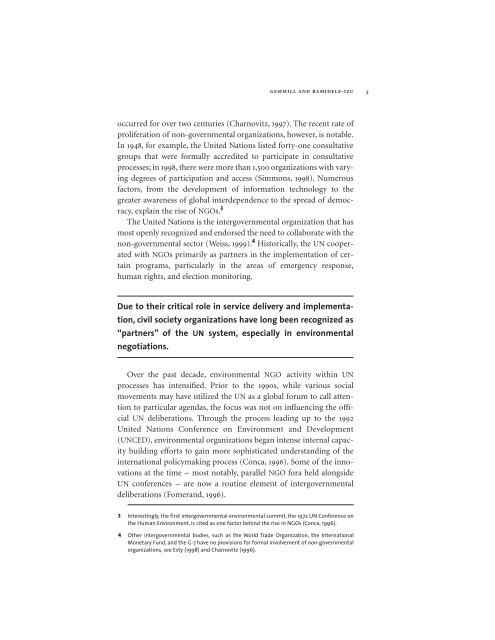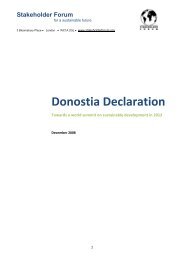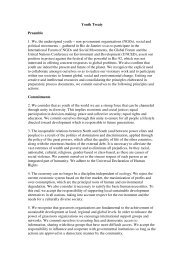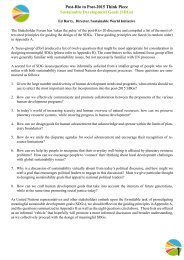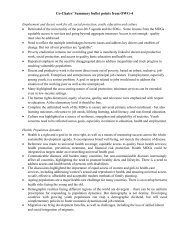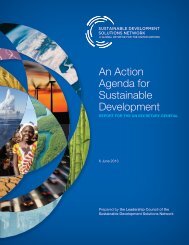The Role of NGOs and Civil Society in Global ... - Yale University
The Role of NGOs and Civil Society in Global ... - Yale University
The Role of NGOs and Civil Society in Global ... - Yale University
You also want an ePaper? Increase the reach of your titles
YUMPU automatically turns print PDFs into web optimized ePapers that Google loves.
GEMMILL AND BAMIDELE-IZU5occurred for over two centuries (Charnovitz, 1997). <strong>The</strong> recent rate <strong>of</strong>proliferation <strong>of</strong> non-governmental organizations, however, is notable.In 1948, for example, the United Nations listed forty-one consultativegroups that were formally accredited to participate <strong>in</strong> consultativeprocesses; <strong>in</strong> 1998, there were more than 1,500 organizations with vary<strong>in</strong>gdegrees <strong>of</strong> participation <strong>and</strong> access (Simmons, 1998). Numerousfactors, from the development <strong>of</strong> <strong>in</strong>formation technology to thegreater awareness <strong>of</strong> global <strong>in</strong>terdependence to the spread <strong>of</strong> democracy,expla<strong>in</strong> the rise <strong>of</strong> <strong>NGOs</strong>. 3<strong>The</strong> United Nations is the <strong>in</strong>tergovernmental organization that hasmost openly recognized <strong>and</strong> endorsed the need to collaborate with thenon-governmental sector (Weiss, 1999). 4 Historically, the UN cooperatedwith <strong>NGOs</strong> primarily as partners <strong>in</strong> the implementation <strong>of</strong> certa<strong>in</strong>programs, particularly <strong>in</strong> the areas <strong>of</strong> emergency response,human rights, <strong>and</strong> election monitor<strong>in</strong>g.Due to their critical role <strong>in</strong> service delivery <strong>and</strong> implementation,civil society organizations have long been recognized as“partners” <strong>of</strong> the UN system, especially <strong>in</strong> environmentalnegotiations.Over the past decade, environmental NGO activity with<strong>in</strong> UNprocesses has <strong>in</strong>tensified. Prior to the 1990s, while various socialmovements may have utilized the UN as a global forum to call attentionto particular agendas, the focus was not on <strong>in</strong>fluenc<strong>in</strong>g the <strong>of</strong>ficialUN deliberations. Through the process lead<strong>in</strong>g up to the 1992United Nations Conference on Environment <strong>and</strong> Development(UNCED), environmental organizations began <strong>in</strong>tense <strong>in</strong>ternal capacitybuild<strong>in</strong>g efforts to ga<strong>in</strong> more sophisticated underst<strong>and</strong><strong>in</strong>g <strong>of</strong> the<strong>in</strong>ternational policymak<strong>in</strong>g process (Conca, 1996). Some <strong>of</strong> the <strong>in</strong>novationsat the time – most notably, parallel NGO fora held alongsideUN conferences – are now a rout<strong>in</strong>e element <strong>of</strong> <strong>in</strong>tergovernmentaldeliberations (Fomer<strong>and</strong>, 1996).3 Interest<strong>in</strong>gly, the first <strong>in</strong>tergovernmental environmental summit, the 1972 UN Conference onthe Human Environment, is cited as one factor beh<strong>in</strong>d the rise <strong>in</strong> <strong>NGOs</strong> (Conca, 1996).4 Other <strong>in</strong>tergovernmental bodies, such as the World Trade Organization, the InternationalMonetary Fund, <strong>and</strong> the G-7 have no provisions for formal <strong>in</strong>volvement <strong>of</strong> non-governmentalorganizations, see Esty (1998) <strong>and</strong> Charnovitz (1996).


